|
Monday, March 2, 2009
Progress Notes
I had the opportunity a couple weeks ago to visit Roberta (Bobbie) Pemberton (photo 01) of Iberia for the purpose of copying a number of old photos which through the years she has collected.
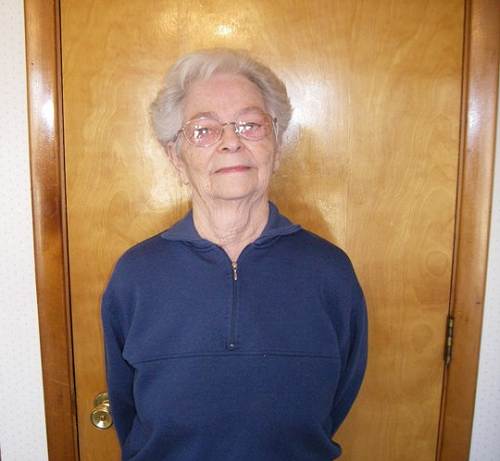
01 Roberta Pemberton
She is one of those Miller Countians whose roots go back many years here and, in addition, she can claim relationship to some of the most noted of our Miller County ancestors of the past. For example, her grandfather on her mother’s side, George Martin, known as the one who started the Iberia Sentinel newspaper, married Laura Ferguson, daughter of Squire John Ferguson, one of the county’s most well known and acclaimed citizens of the past (photo 02).
Martin.jpg)
02 George and Laura (Ferguson) Martin
And her grandfather on her father’s side, Selby John Heltzell (photo 03), was a very well liked “drummer” who for many years represented the H.W. Gildehaus firm.
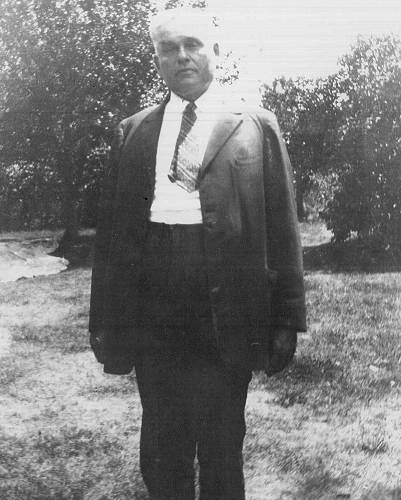
03 Selby John Hetzell
Her grandfathers were considered important enough citizens by author Gerard Schultz (photo 04) that he included both their biographies in his list of the most prominent personalities of late 19th and early 20th century Miller County.
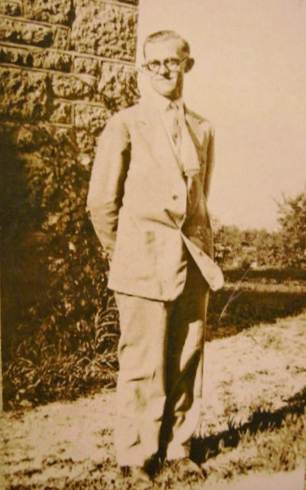
04 Gerard Schultz
Of course, in addition, Gerard certainly included the biography of Roberta’s great grandfather, Squire John Ferguson in his list (photo 05).

05 Squire Ferguson at Iberia Encampment
Click image for larger view
Roberta has photos of all three of these famous ancestors of hers so I thought it would be of interest to copy here the Schultz biography of each accompanied by Roberta’s photos.
Selby John Heltzell (photo 06)
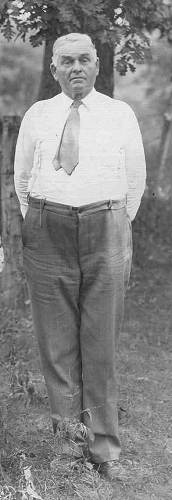
06 Selby John Heltzell
Click image for larger view
By Gerard Schultz
Selby John Heltzell, a widely-known salesman, was born at Glencoe, Missouri, on August 27, 1868. His father, George Heltzell, and his mother, Priscilla (Harrier) Heltzell, were born of German Parents at Bedford, Pennsylvania, the former on August 19, 1834, the latter May 10, 1840.
On January 30, 1895, at Iberia, Mr. Heltzell was married to Miss Samantha Josephine Mace, daughter of Thomas Mace and Julia Ann (Tate) Mace of Gallatia, Illinois. The children born to this marriage were: May, who died at two years of age; Edna, who married M.J. Davidson, state highway contractor; Eska (photo 07), who is a graduate of the University of Missouri and who married Robert E. Fendorf, attorney; John, who attended Iberia Academy and who married Lena Martin; George Dallas, who graduated from Drury College in 1930; and Mary Louis, who is now attending Iberia Academy.
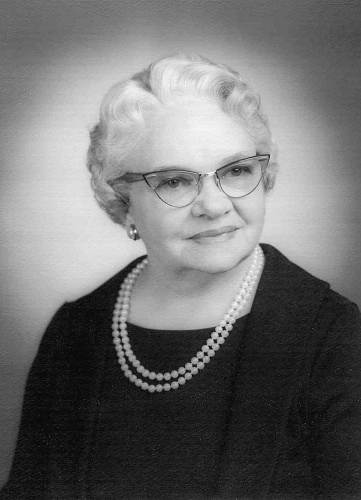
07 Eska Heltzell Fendorf
Mr. Heltzell has been a traveling salesman for the firm of H.W. Gildehaus for 31 years. He was chairman of the Republican Miller County Committee in 1908. He has always found time to cooperate in those measures which contributed to the up-building and progress of the community. He has been a member of the Board of Trustees of Iberia Junior College for about 20 years, 16 of which he has been chairman of the Board, a member of the Town Board of Iberia for several terms, and commissioner of the Iberia Special Road District for six years. He was an important factor in the establishment of the Iberia Canning Company. He is a trustee of the Congregational Church.
Peggy Hake researched the Heltzell family and wrote a short narrative which is on our website but for convenience I will copy it here. She begins with the father of Selby, George Heltzell:
GEORGE HELTZELL
George Heltzell was born in Bedford, Pennsylvania on August 2, 1834. In 1860 he married Priscilla Harrier. She was born 10 May 1838 in Pennsylvania. Both the Heltzell and Harrier families were probably of German descent. Many immigrants of Germany and its provinces settled in Pennsylvania in the 1700s and 1800s.
In 1864, George and Priscilla moved to Glencoe, St. Louis County, Missouri and stayed there for 19 years.
About 1883 they came to Iberia, Richwoods Township.
George and Priscilla were parents of four children including:
1. Sarah/Sadie E. Heltzell 1861-1964, m. Wm. L. Farnham 24 Jan 1886
2. Samuel Grant Heltzell 1866-1913 m. (no record)
3. Anna E. Heltzell 1870-1954 m. George I. Farnham l Nov 1891
4. Selby J. Heltzell 1874-1928 m. S. Josephine Mace 30 Jan 1894
NOTE: George and William Farnham were brothers, sons of David and Henrietta Farnham (of Maine & Pennsylvania). Josephine Mace was a daughter of Thomas and Julia (Tate) Mace of Illinois.
George Heltzell died in Iberia on December 30, 1922 at the age of 88 years. He was survived by his three children (Selby, Sadie, and Anna) and by three sisters who lived in St. Louis and Kansas City (they were not named in his obituary). George's funeral service was held at the Congregational Church in Iberia conducted by Dr. G. Byron Smith of Iberia Academy. He was buried in Iberia Cemetery next to his wife, Priscilla, who had died May 12, 1893.
My Mother, Susie Bear Pryor, told me she remembered Mr. Selby Heltzell taking orders from her parents when they ran the Bear General Merchandise store in Tuscumbia in the 1920’s and 1930’s. Mom said that in addition to H. W. Gildehaus she believes Mr. Heltzell also at one time was a sales person for the Shyrack Hirst wholesale distributing company of Jefferson, City which still exists in Jeff. Mom said that the term “Drummer” often was used for traveling salespeople years ago and was not a derogatory term. For more information about “Drummers” I refer you to the following website:
http://www.drbilllong.com/2006Words/Drummer.html
George Martin (photo 08) was Roberta’s grandfather on her mother’s side of the family.
Martin2.jpg)
08 George and Laura (Ferguson) Martin
He was the one who, as noted above, started the Iberia Sentinel newspaper, which, in contradistinction to quite a few other Miller County newspapers of the past, is still being published by its present owners, the Vernon Company of Eldon as a combined paper with the Tuscumbia Autogram. Here is the Gerard Schultz biography of George Martin:
George Monroe Martin
By Gerard Schultz
George Monroe Martin, editor and publisher of the Iberia Sentinel, was born at Tavern, Maries County, Missouri, December 5, 1889, a son of James Oliver Martin and Margaret (Rowden) Martin, both of whom were born near Vienna, Missouri, and whose ancestors were native Missourians.
Mr. Martin received his education in the public schools of Maries County and the Iberia Academy. For several years he engaged in the general mercantile business, and from 1904 to 1915 he served as postmaster at Iberia (photos 09, 10 and 11).
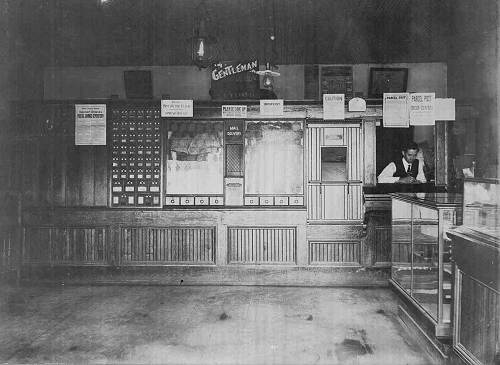
09 George Martin - Postmaster
Click image for larger view
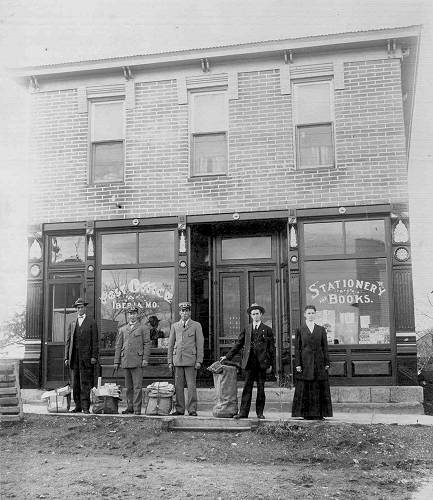
10 Left to Right: Clifford Clark - Rural Carrier, John Music - Rural Carrier, Harry Ferguson - Rural Carrier,
George Martin - Postmaster and Laura Ferguson
Click image for larger view
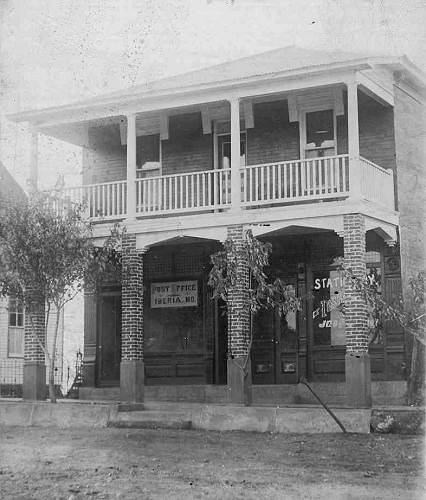
11 Post Office Building Remodeled with Porch
His experience in the journalistic field covers a period of 20 years, having been editor and publisher of the Iberia Sentinel since 1913 (photos 12 and 13).
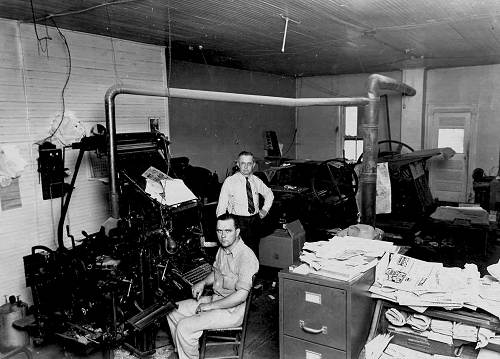
12 Glen Martin (sitting) and George Martin (standing) - Iberia Sentinel
Click image for larger view
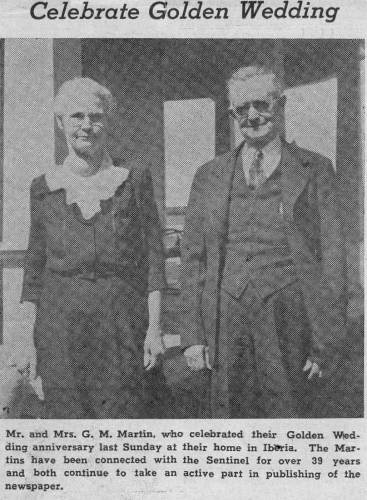
13 George and Laura (Ferguson) Martin - Fiftieth Wedding Anniversary
Click image for larger view
He has shown an interest in community affairs and has manifested a high degree of ability in both his professional work and public service. He was clerk of the local camp of the Modern Woodmen of America for a number of years, and is now a member and clerk of the Iberia Public School Board, and a member of the Board of Trustees of Iberia Junior College.
On June 22, 1902, he was married to Miss Laura Ferguson, daughter of Mr. and Mrs. John Ferguson. Mr. Ferguson is of Scotch ancestry, and Mrs. Ferguson was English. Children born to this marriage were: Lena, who married John Heltzell; Grace, who married Orville Wyrick; Herbert and Glenn, who are linotype operators; and Lois Marie, who is deceased. Mr. Martin belongs to the Congregational Church, and in his political beliefs is a Republican.
Peggy Hake has written about the origin of George Martin’s family in Miller County on our website but for convenience I will copy it here:
JAMES OLIVER MARTIN
James Oliver Martin was born near Tavern, Maries Co., MO (then Osage County) on 15 May 1844, a son of George W. Martin and his first wife, Mary Ann Vaughan. George Martin was the father of 8 children by four wives (Mary Vaughan, Louisa Atkinson, Nancy Hughes, and Elizabeth Breeding). The children were: William Martin, James Oliver Martin, John Martin, Lucinda Martin, Louisa Martin, Leander/Lee Martin, Elijah Martin, and Benjamin Martin.
James Oliver Martin married Margaret E. Rowden 5 March 1868. Margaret was born circa 1848, a daughter of Rufus and Mary Rowden (Note: I think this is incorrect-Margaret may have been the daughter of James E. and Margaret (Lawson) Rowden). She and James were parents of 7 children: Josephine Martin b. 1870 m. Elbin Duncan; Mary Isabella Martin b. 1872 m. Joseph Rowden; Bertha A. Martin b. 1874 m. Everett Gardner; George Monroe Martin b. 1878 m. Laura Ferguson; William Elmer Martin b. 1881 m. Maggie Koester; Chester A. Martin b. 1885 and Elva D. Martin (1889-1901).
In the Maries County census of 1881, James and Margaret were living in Boone Township. According to census records his parents were natives of Georgia and Kentucky while Margaret's parents were from Alabama and Tennessee. The Rowdens were from Roane County, Tennessee, but some of the family members did venture down to DeKalb County, Alabama. The neighbors to the Martins in 1880 were the families of Wilson, Rowden, Lawson, Shelton, Kinworthy, Crismon, and Barr.
By 1900, James and Margaret had moved to Miller County and were living in the village of Iberia. Their three older daughters probably married in Maries County because no record of their marriages were found in Miller County. The oldest son, George Monroe Martin, married Laura Ferguson in Miller County on 22 June 1902. She was a daughter of Squire John and Dorcas (Shelton) Ferguson. William Elmer Martin married Maggie E. Koester in Miller County in 1903. No record of a marriage for Chester Martin was found and evidently the youngest child, Elva, died at the age of 12 years in 1901.
James Oliver Martin was a Union soldier during the Civil War. He was a private in Company M, Regiment 3 of the Missouri Cavalry. He enlisted on 15 Aug 1862 and was discharged 29 May 1865. During his time of military service he incurred a gunshot wound to his ankle.
In 1890, his address was Tavern, Maries Co., MO. Apparently the Martin family moved to Miller County during the decade of the 1890s. James Oliver Martin was a member of the Iberia Miles Carroll G.A.R. Post for several years before his death. This post of old Civil War Union soldiers was an active organization for many years in the Iberia community.
Margaret (Rowden) Martin died in 1903 at her home in Iberia and James then married Mrs. Susan Meredith in 1905. I believe Susan was the widow of Zachariah Meredith whom she married in 1877. Susan was a daughter of Andrew and Elizabeth Wilson of Glaize Township, Miller County.
James Oliver Martin died 12 January, but I haven't been able to find the exact date of his death. He was living in Eldon, MO with his second wife when he died. Susan died in 1933 and is buried in the Eldon Cemetery but there is no record of James being buried in Eldon. I suspect he was brought back to Iberia and perhaps buried in the cemetery there. Several members of his family were laid to rest in the Iberia Cemetery.
NOTE: According to an obituary I found for James O. Martin, it states he was buried at Iberia Cemetery, but there is no inventoried record or gravestone there for him.
Thanks again, Peggy.
And now to the ancestor of Roberta, who is probably one of the most remembered Miller County figures from the past, Squire John Ferguson. He is Roberta’s great grandfather because her mother Lena’s father, George Martin, married Laura Ferguson, daughter of Squire John. Much has been written about Squire John Ferguson. First, I will once again copy Gerard’s Schultz’s biography of Squire John taken from Schultz’s “History of Miller County” published in 1933:
Squire John Ferguson
History of Miller County
By Gerard Schultz
Squire John Ferguson, Iberia’s “grand old man,” was born on December 25, 1838, at Dumfries, Scotland. When he was fourteen the family emigrated to the United States. His father died while crossing and was buried in the Atlantic. John landed at New Orleans, Louisiana, and at once took a steamer to St. Louis. In 1853, he began to work on the Mississippi River steamer as a deck sweeper, at a salary of $15.00 and board (photo 14).
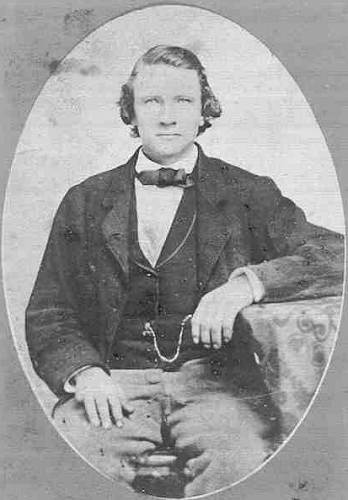
14 John Ferguson
At the outbreak of the war he was night watchman on steamer New Falls City, which operated between St. Louis and New Orleans with Captain Henry Switzer. From New Orleans Mr. Ferguson went to his grandfather’s home in Maries County. On June 4, 1862, he was united in marriage to Miss Dorcas C. Shelton, of Miller County (photos 15 and 16).
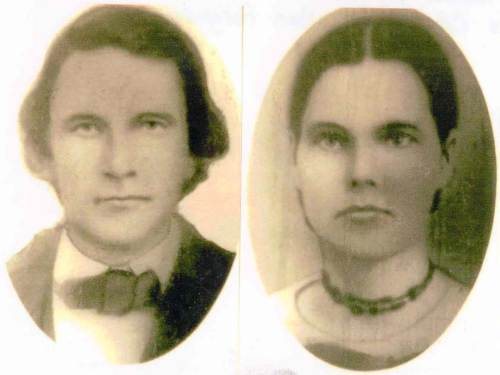
15 John Ferguson and Dorcas
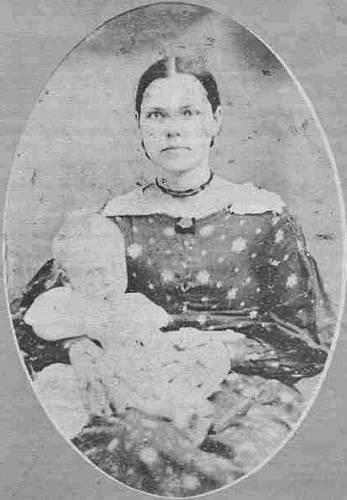
16 Mrs. John Ferguson
He enlisted on August 15, 1862, in the United States Army at Rolla, Missouri, in Company M, Third Missouri Cavalry Volunteers. This company operated in Missouri, Arkansas, Mississippi, and Louisiana. He served in this regiment until September 27, 1865. He was discharged at New Orleans. His first vote was cast for Abraham Lincoln, in 1864.
Mr. Ferguson has always been very active in public affairs. For many years he was chairman of the Village Board of Trustees of Iberia and for over fifty years has been justice of the peace. He was a charter member of the Miles Carroll Post Number 111 of the G.A.R. and has been commander of this post since 1885. On May 16, 1928, he was elected Department Commander of the G.A.R. of the State of Missouri. He has attended all of the National G.A.R. encampments since the time of its organization, with the exception of one or two, when illness prevented. The trips to the national encampments have taken him as far east as Portland, Maine, and as far west as Portland, Oregon (photos 17, 18 and 19).
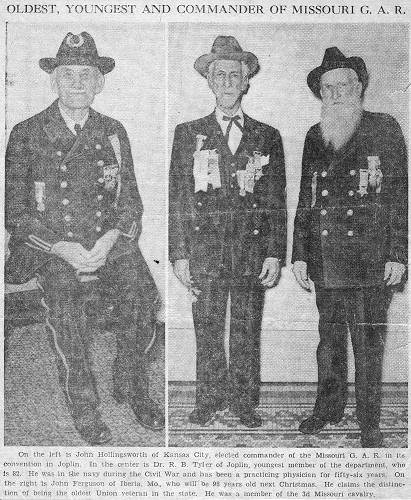
17 Oldest and Youngest Members of GAR
Click image for larger view
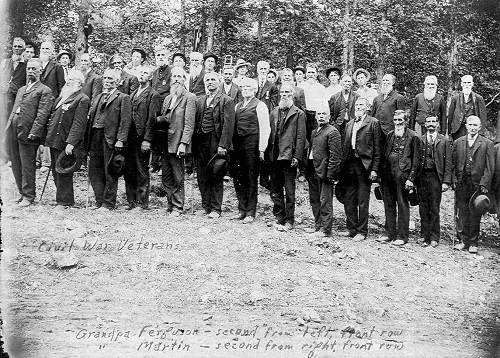
18 Civil War Veterans: John Ferguson 2nd from Left - George Martin, Father 2nd from Right
Click image for larger view
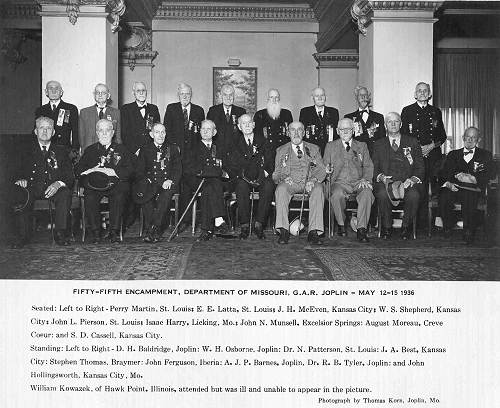
19 Encampment - 1936
Click image for larger view
Mrs. Ferguson died January 18, 1920. Fourteen children had been born to Mr. and Mrs. Ferguson: William T. Ferguson, born May 20, 1863, who died January 14, 1932; Elizabeth Ferguson, born June 2, 1866; Charles D. Ferguson, born October 24, 1867; Edmond S. Ferguson, born October 16, 1868; Frederick P. Ferguson, born October 24, 1869; George F. Ferguson, born October 23, 1871; John R. Ferguson, born October 7, 1873; Joseph Ferguson, born December 10, 1875, who died in infancy; James Ferguson, born December 25, 1876, who also died in infancy; Isabella Ferguson, born February 19, 1878; Laura Ferguson, born June 11, 1881; Harry H. Ferguson, born April 6, 1884; Frank Ferguson, born June 11, 1887; and Martha Ferguson, born June 27, 1889 (photo 20).
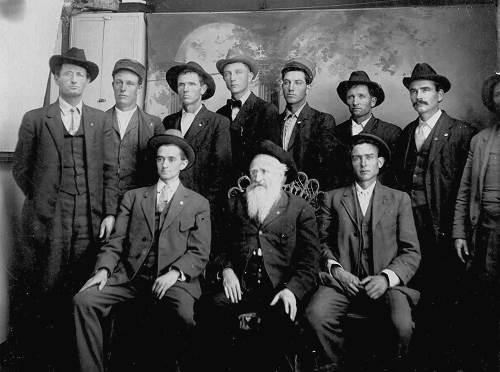
20 John Ferguson with two Sons-In-Law on Each Side
Although a man of 94 years, Mr. Ferguson’s gait is firm and his bearing that of a true soldier.
While the biography by Gerard Schultz above is a beginning it by no means communicates the extent to which Squire John’s influence in Miller County extended during his lifetime. For one reason, Schultz’s biography was written before John Ferguson had passed away. He was called upon for almost every public event of importance to be a master of ceremonies or at least to make a speech. For example, he was a key figure in the Miller County Centennial proceedings of 1937. (Go to these two websites to read about the Centennial where you will find many more photos:
http://www.millercountymuseum.org/newspapers/centennial_millerco.html
and
http://www.millercountymuseum.org/events/centennial.html)
He was also one of the major speechmakers in the opening ceremonies of the new Osage River Bridge at Tuscumbia in 1933. (Go to this website to read about the bridge:
http://www.millercountymuseum.org/events/bridgededication.html)
If you were to insert the name Ferguson into our website search engine, you would find probably more references to John Ferguson than any other public figure. He attended and participated in about everything. For example, here is the Iberia Turkey Day, which looks in this photo as if it were almost as big as the Eldon Turkey Festival (photo 21)!
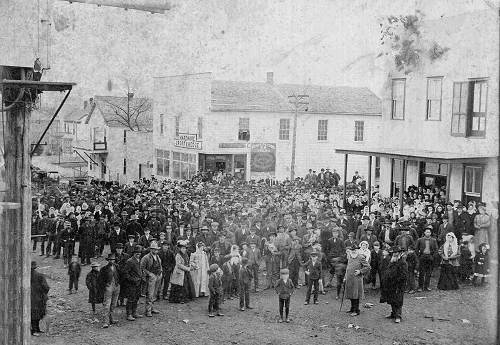
21 Turkey Day in Iberia
Click image for larger view
And he certainly wouldn’t have missed the occasion of riding in Alf Eads’ new airplane taking off from Miller County’s first airport (photo 22)!
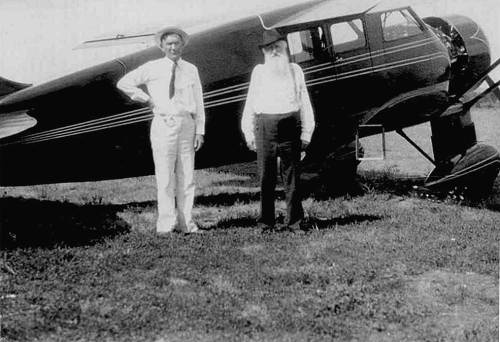
22 Alf Eads and John Ferguson
However, for the best and most complete biography of John Ferguson I refer you to the narrative about him on our People section of the Yesteryear heading on our website as written by museum director, Nancy Thompson. Nancy also was a great granddaughter of John Ferguson. Go to the URL below to read Nancy’s narrative about John Ferguson:
http://www.millercountymuseum.org/people/bio_f.html
So much has been written about Squire John that I really can’t place it all on the Progress Notes so I really have to refer you to these other URL’s on our website, especially the one by Nancy.
You will need to scroll about half way down the page to get to Nancy’s biography of John Ferguson which includes many photos.
I want to thank Roberta for all the time she spent getting out her old photos of members of her famous Miller County ancestors from the past. It really is insightful to have the opportunity to speak with relatives and friends of the people I present on this page because sometimes an interesting piece of history is learned about them that might have escaped the attention of those who wrote their history originally.
Once in a while we find something really unusual hidden away in storage in the old museum building which was the case last week when we found item accession number 1981 donated to us in 1996 by Howard Wall who lived in Shawnee Mission, Kansas at the time of the donation. We don’t have contact information with Howard any more but our records indicate he was the son of James Everett Wall and Minnie Howard. James was the son of David T. Wall and Nancy Katherine Blankenship. We can’t say we are one hundred percent sure this is the same Howard Wall but more than likely it is. At any rate, what was donated was a “caponizer” set including instruments and instructions (photos 22a and 22b).
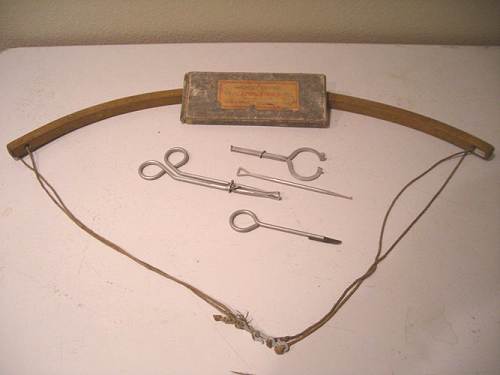
22a Beuoy Caponizer
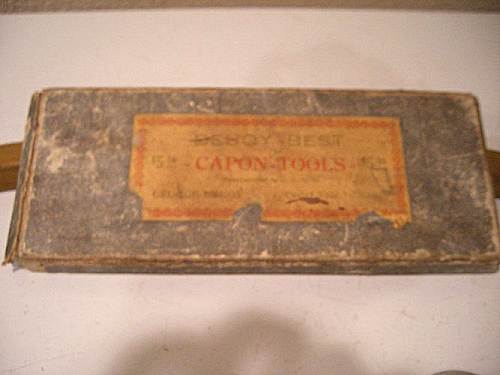
22b Capon Tools
Ordinarily, in days gone by now, a few roosters might arrive from the hatchery with the hen chicks ordered by the farmer’s wife for laying hens and the roosters would have been fried and eaten when big enough. But in the early 1900’s when caponization was being introduced, the farmers discovered that the capons produced could get up to ten to fifteen pounds in weight which brought more value for trading at the store or food for the table. I don’t think caponization was used much around here; at least, a couple of people I talked to who used to keep laying hens years ago hadn’t done it. For example, here are some comments I received from Elmer Brown who used to have laying hens on his farm as a boy:
“Well, the process is basically castrating young roosters so they will, in fact, grow bigger and fatter. To find out probably more than you want to know on the subject simply Google "Capons". There are several articles on the subject.
The roosters’ testes are contained inside the body cavity. I doubt that the technique of feeding of estrogen to accomplish the same result was developed at that time. We never practiced it since we didn't raise chickens for market. The only ones we ate were frying size roosters. However, I have this vague recollection that the MU extension service used to offer training sessions on how to do the castration process. I'm not sure whether it was someone from MU or the county extension agent who did the training. I don't even recall knowing anyone who participated. As I said before, I never had any experience with the process since we never raised chickens for meat other than our own consumption.
As one of the Google articles points out it doesn't seem to be done much anymore except on a small, boutique scale. Most of the chickens you and I buy in the super market are broilers (probably many of them raised there in Miller County) typically about 10 to 12 weeks of age. It wouldn't be necessary to caponize those. More than likely, what we get in canned chicken soup, etc., are the hens and mature roosters that have past their prime for laying eggs and producing fertilized eggs for hatching.”
Thanks Elmer.
But apparently Howard Wall or one of his antecedents had used this procedure since it was he who was the one who gave us the Beuoy Caponization set that we have at the museum.
I thought it would be interesting to copy here the instructions recommended by inventor, George Beuoy of Cedar Vale, Kansas, regarding the caponization procedure with the use of his personally designed instruments:
Instructions…”Beuoy Best Set” (photo 23)
George Beuoy
Cedar Vale, Kansas
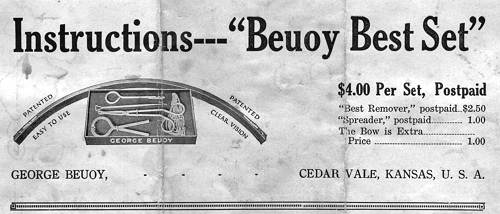
23 Beuoy Advertisement
Click image for larger view
The beginner should start on a bird of the American or English breeds. Select one about like a quail in size and appearance, weighing between one and two pounds, more than six weeks and not over ten weeks old (photo 24).
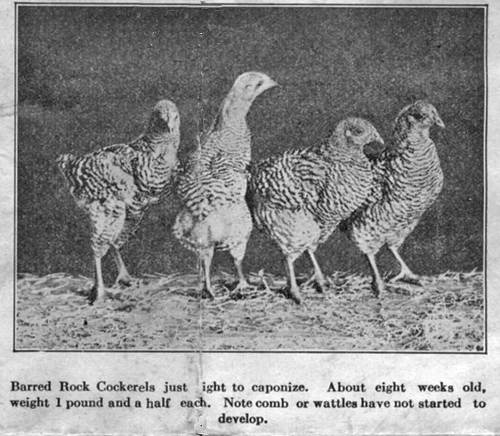
24 Ready to be Caponized
Click image for larger view
Commence on a dead bird, one that has just been killed to eat. It will not be damaged for food at all. Work on one or two in that way and you will become accustomed to handling and using the tools. You can then proceed with confidence and success on a live bird. Dead or alive, be absolutely sure the birds have not had any feed or water for at least thirty six hours before the work is attempted. Keep off feed and water for two nights and one day. Confine them in a dark, cool place; it is no hardship on the birds. It requires that long for nature to empty their crops and intestines, which is very necessary. See to the above conditions and the operation will not hurt the birds in the least. Only an ignorant or cruel person would attempt to caponize a bird that is full of feed and water.
When practicing on the dead bird, proceed as above so it will be in the same condition as the live ones to follow. When you are ready to operate, adjust the legs of the “Beuoy-Bow-Table” so the top of the table is on the level with your elbows. Place it in a good light. Pass one bow cord around both wings of the bird and catch. Then draw the other end of cord around the disc holder on end of bow and draw tight. It will hold of its own accord. Pass the other bow cord around both feet and catch. Pull on the other end until the bird is stretched out its full length. Then pass the cord around the disc holder and draw tight (photo 25).
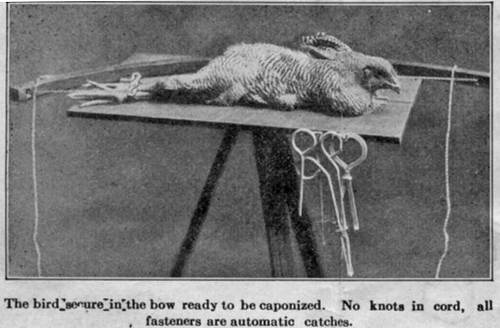
25 Securing the Chicken
Click image for larger view
The bird is now secure in the “Beuoy-Bow.” You can handle him any way you please (photo 26).
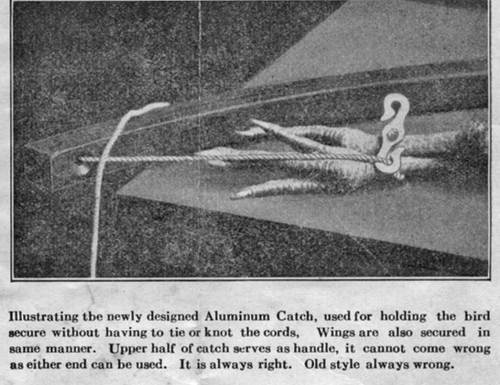
26 No Knots or Ties
Click image for larger view
Work from one or both sides as you choose and without loosening the bird. Pluck a few feathers just in front of the hip joint (these are ready to moult anyway and will come out easy). Stand on the front side of the bird so that the breast is toward you. Locate the last two ribs with the forefinger of the left hand. With the right hand, place the blade of the knife between them. Hold it there with a firm steady pressure, draw it toward you, bearing down very hard all the time. Be sure the point of the blade passes through, entirely separating the ribs. Make the cut about one inch long, the idea being to separate the ribs without cutting any muscle. If the blade passes through at the first attempt, no bleeding will follow (photo 27).
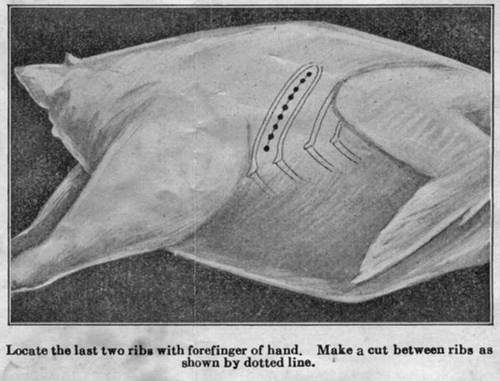
27 First Cut
Click image for larger view
The cut made, insert the spreader and open the wound so you can see to work. The first thing you will see is a thin skin or membrane, covering the intestines. With the tearing hook (photo 28), make a small opening in this, which will bring the upper gland into view, a small yellowish object about the size of a navy bean, lying up against the backbone or nearly so, with a blue artery just back of it and sometimes attached to it.
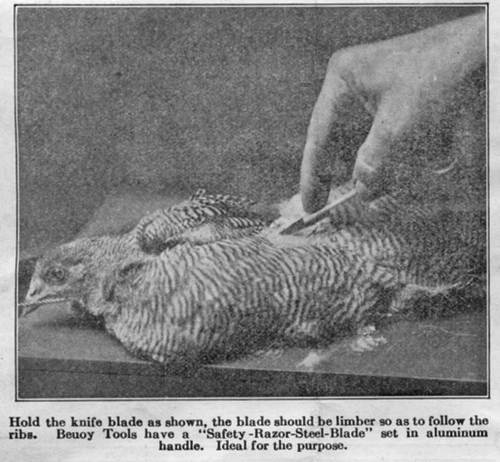
28 Special Blade
Click image for larger view
Care must be taken not to cut or tear this artery or the bird is a dead one (photo 29).
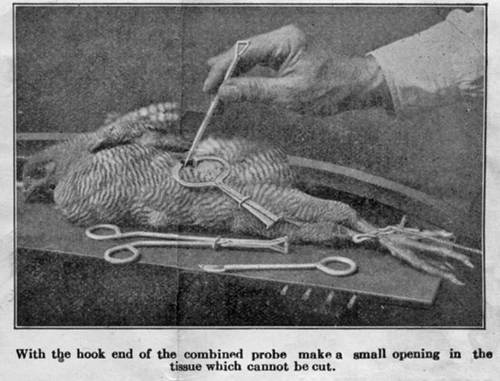
29 Tissue Opening
Click image for larger view
Insert the “Beuoy-Remover” with the loops held tightly together pushing the intestines back and out of the way with it when necessary (photo 30).
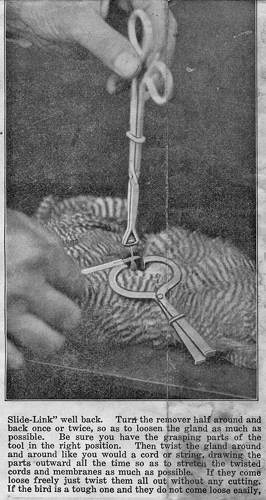
30 Beuoy Remover
Click image for larger view
You will be able to see through the loops of the “Beuoy-Remover.” When you have it in the right place open up the instrument just enough to pass over the gland and allow to close slowly, with the gland inside the loops. Then draw the “Safety-Slide-Link” well back. Turn the remover half around and back once or twice, so as to loosen the gland as much as possible. Be sure you have the grasping parts of the tool in the right position. Then twist the gland around and around like you would a cord or string, drawing the parts outward al the time so as to stretch the twisted cords and membranes as much as possible (photo 31).
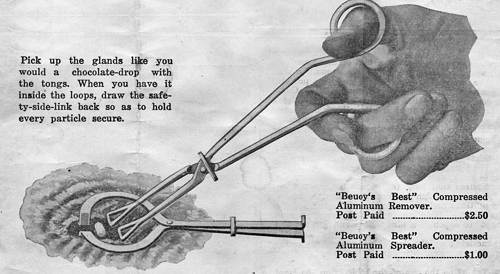
31 Removing the Gland
Click image for larger view
If they come loose freely just twist them all out without any cutting. If the bird is a tough one and they do not come loose easily, reach in with the small knife blade and cut the twisted cords and membranes off about half way between the gland and where it attaches to the bird (see illustration). Remove the spreader, turn the “Beuoy-Bow,” bird and all over and repeat the operation on the other side, proceeding as before. It is possible to get both glands from the same side but is harder and more dangerous to do. The bird recovers quicker where it is opened up on both sides. Do not sew up the cuts. When the new capon gets upon his feet, the cut in the skin will be under his wing and not over the ribs at all. They should be watered at once, also promptly fed, the same as usual. The birds are now fixed to add real coin to the “Pot-of-Gold.”
Care After Operation
They will be ready for their feed as soon as turned loose but should be watered first. Feed lightly of whatever they are accustomed to. Be sure to separate them so that not over eight or ten will go to roost in any one coop, as where there is a large number together they will crowd and smother. After the second night following the operation they will be all right and may then be safely turned together. In three of four days after the operation some of the capons may develop wind puffs. This is caused by the cut healing too fast. It is not serious, only air or wind under the skin, which cannot escape. The remedy is to take a long stitch, one inch and a half at least, with a common darning needle through the puffed part with a No. 20 white thread. Bring the ends of the thread together and tie tightly in a hard knot. Be sure the two needle holes in the skin are drawn together so as to enlarge the openings. The air will escape at the needle holes while the thread will keep it open. The tread will come out in due time of its own accord. This is just the outer skin of the bird and is void of feeling, so does not cause the fowl any suffering. This will not be necessary in very many birds, but once in a while it will occur.
In three or four days after the operation the capons may be allowed the free run of the place. They are great rustlers, more like a hen in action and appearance than anything else. Yet they are different from all other feathered creatures, taking on fat in surprising amounts in proportion to the feed consumed. They will begin to heavy down and show that they are capons when about six months old. The American breeds will if crowded along, weigh from 10 to 15 pounds when they are ten months of age. The operation may be performed at any time in any month of the year if the birds can be found that are right.
George Beuoy must have had some success selling his caponization set to farmers since he wrote several books about the subject back in the early 1900’s. Here is a list of the books Beuoy wrote:
1. |
Capons for profit
by George Beuoy
Publisher: Cedar Vale, Kan. : G. Beuoy, 1923. |
2. |
Capons and caponizing
by T E Quisenberry; George Beuoy; S K Burdin; American Poultry School.;
Publisher: Kansas City, Mo. : American Poultry School, ©1923. |
3. |
Capon gold
by George Beuoy
Publisher: Cedar Vale, Kan. : The author, 1926. |
4. |
What's a capon and why the profit?
by George Beuoy
Publisher: Cedar Vale, KS : George Beuoy, ©1918. |
5. |
What's a capon and why?
by George Beuoy
Publisher: [Kansas City, Mo., F.P. Burnap, stationery and Print. Co.], ©1912. |
6. |
Dingley Dell Farm, Cedar Vale, Kansas.
by George Beuoy;
Publisher: [Cedar Vale, Kan. : G. Beuoy, 191-] |
We are very grateful to Board member, Jim Clark (photo 33), who made for us a new sign for the museum (photo 34).
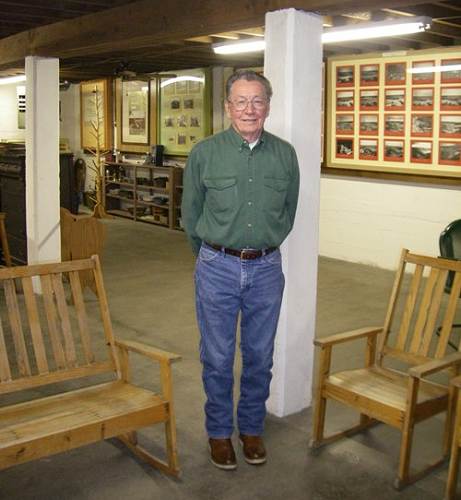
33 Jim Clark
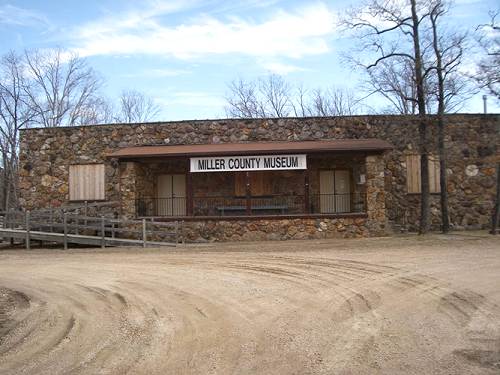
34 New Museum Sign
The old one was not sturdy and the lettering was becoming faded. Jim is also making and finishing new cabinets for us in our museum kitchen (photo 35).
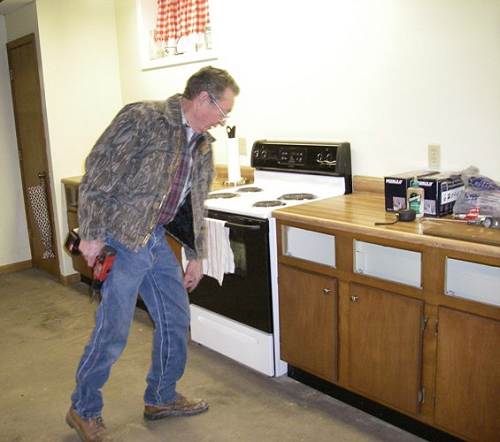
35 Jim Clark
Jack Wiggins (photo 36) and Brice Kallenbach (photo 37) are continuing to paint the entire lower level of the museum as well as various furniture items and doors.

36 Jack Wiggins
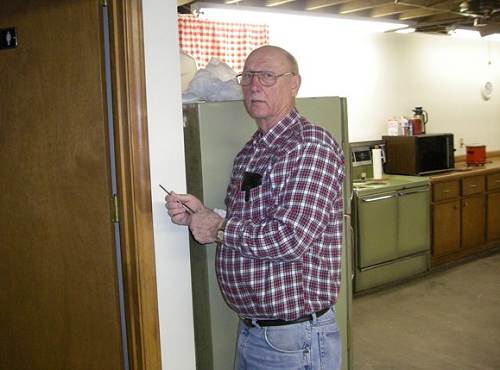
37 Brice Kallenbach
Dwight Weaver, well known local author who has written several books about the early history of the Lake of the Ozarks and surrounding area, was at our museum recently to work with us in planning a new exhibit which will feature many of his photographs taken years ago when the Lake area was first developing (photo 38).
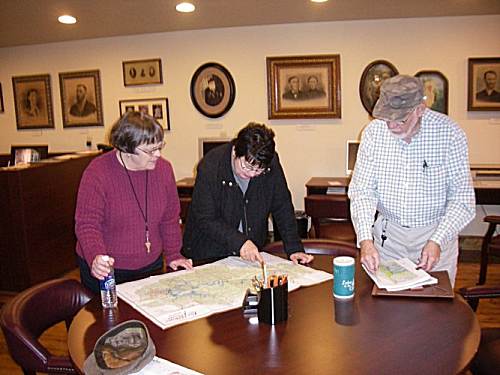
38 Nancy Thompson, Judy Pryor and Dwight Weaver
Dwight’s collection was accumulated over many years during his interviews of many of the people who first settled along the lake shore to establish stores, cabin courts, and other businesses. From these interviews Dwight gathered the material for his books. The photographic display, which will be chronologically and geographically arranged, is going to be located on the lower floor of the new museum building addition. We plan to have the display completed to coincide with our “Grand Reopening” scheduled for mid May of this year. You won’t want to miss seeing this impressive collection of photographs displaying some of the earliest businesses to locate at the Lake back in the 1930’s, 40’s and 50’s.
Martha Suttie was our quilt maker volunteer this last week helping Elva Steen to finish the raffle quilt in time for display for the summer season (photo 39).
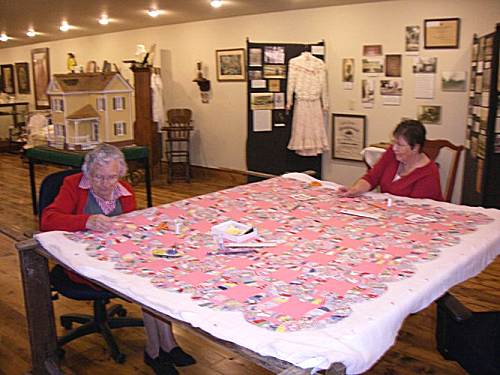
39 Elva Steen and Martha Suttie
That's all for this week.
|



